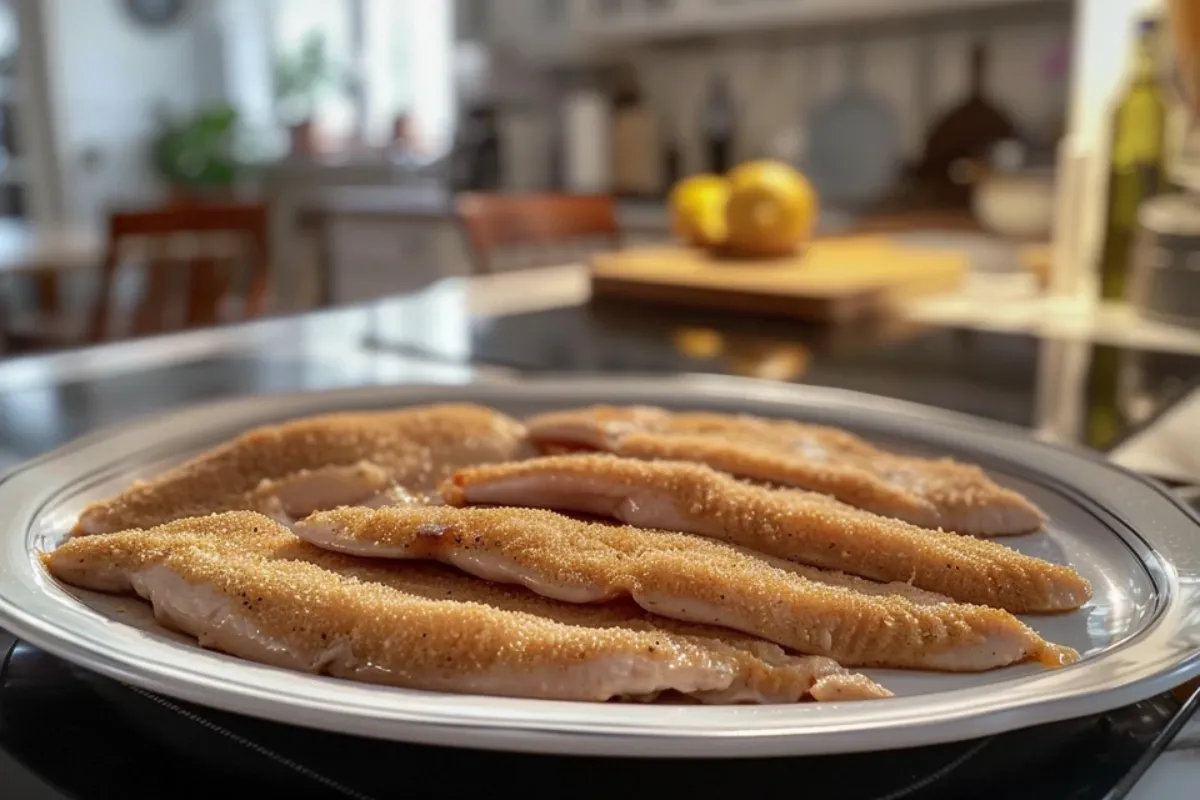Chicken Breast vs. Escalope : this article explains the differences between chicken breast and escalope, clarifying preparation and use. Learn about these common cuts of chicken and improve your cooking!
Understanding Chicken Breast
Chicken breast is a popular cut of poultry. It comes from the pectoral muscle of the chicken. Additionally, it’s known for being lean and versatile. Moreover, chicken breast is a staple in many diets. It is frequently used in various recipes. Generally, it is sold boneless and skinless. Therefore, it’s very convenient to use. However, you can also find bone-in and skin-on options. Furthermore, chicken breast can be cooked in numerous ways. For example, you can grill, bake, or fry it. Subsequently, it is easy to adapt to many flavors.
Characteristics of Chicken Breast
-
Appearance: Chicken breast is typically thick. It has a rounded, oval shape. Moreover, it has a smooth, light pink surface when raw.
-
Texture: The texture is firm and dense. Additionally, when cooked, it becomes tender. However, it can become dry if overcooked.
-
Versatility: It is very versatile. Consequently, you can use it in salads, sandwiches, and entrees.
-
Preparation: It needs some preparation before cooking. However, it is usually minimal.
-
Cooking Time: Cooking time varies depending on the method. Generally, it cooks quite quickly.
Common Uses for Chicken Breast
-
Grilled Chicken Breast: A healthy option for a quick meal.
-
Baked Chicken Breast: Often seasoned and baked with vegetables.
-
Fried Chicken Breast: Used in many comfort food recipes.
-
Chicken Salads: Cooked and diced chicken breast is common.
-
Sandwiches: Thinly sliced chicken breast is used.
Delving into the Chicken Escalope
An escalope, also known as a chicken cutlet, is a thin, boneless slice of meat. Chicken escalopes are traditionally made by butterflying a chicken breast. Consequently, this creates a thinner, wider piece of meat. Alternatively, the chicken breast can be pounded to achieve the same effect. Chicken escalope is prized for its quick cooking time. Thus, it is a good option for busy weeknight meals. Furthermore, it is a popular choice in many European cuisines.
Key Attributes of a Chicken Escalope
-
Appearance: It is thin and flat. Therefore, it has a larger surface area compared to a regular chicken breast.
-
Texture: Chicken escalope has a more delicate texture. It cooks more quickly due to its thinness.
-
Preparation: Escalopes require more preparation than a chicken breast. Furthermore, they need butterflying or pounding.
-
Cooking Time: Chicken escalopes cook very quickly. Usually, within a few minutes.
-
Versatility: It is used in various cooking methods. However, it is commonly pan-fried.
Popular Culinary Applications of Chicken Escalope
-
Pan-Fried Chicken Escalope: Often breaded and cooked in butter or oil.
-
Chicken Escalope with Lemon Sauce: A classic dish using a simple sauce.
-
Chicken Escalope Parmigiana: A popular Italian-American dish.
-
Chicken Escalope Milanese: A breaded, fried cutlet.
-
Quick Stir-Fries: Thin chicken escalope cooks quickly in stir-fries.
Comparing Chicken Breast and Escalope Naturally :Chicken Breast vs Escalope
The main difference between chicken breast and escalope lies in their preparation and thickness. Specifically, chicken breast is a whole cut. Conversely, an escalope is a thinly sliced or pounded piece of chicken breast. Chicken breasts are typically thicker and require more cooking time. Additionally, chicken escalopes are much thinner and cook rapidly. Therefore, the choice between them depends on the recipe. It also depends on your preference.
| Feature | Chicken Breast | Chicken Escalope |
| Thickness | Thicker and more substantial | Thinner and flatter |
| Shape | Rounded and oval | Flat and wide |
| Preparation | Minimal preparation needed | Requires butterflying or pounding |
| Cooking Time | Longer cooking time needed | Shorter cooking time needed |
| Texture | Firmer and denser | More delicate and quicker to cook |
How Preparation Affects the Cooking Process
Chicken breast is usually cooked whole or in larger pieces. Conversely, escalope is prepared by slicing and pounding the chicken breast. This significantly reduces cooking time. Therefore, escalopes are preferred in recipes that need quick cooking. In contrast, chicken breast is used in dishes requiring longer cooking times. Additionally, both can be seasoned in various ways. Chicken breast is often roasted or grilled, retaining moisture. Chicken escalope is best when pan-fried or sauteed, since the method promotes a crispy exterior and a tender interior. Moreover, the difference in preparation naturally affects the end result of the dish. For instance, a chicken breast that is roasted whole will have a different flavor and texture than a pounded chicken escalope.
Flavor and Texture Differences When Cooking
The cooking method influences flavor and texture. A chicken breast can be roasted whole. Thus, it tends to have a juicy texture. In comparison, a chicken escalope, which is usually pan-fried, can achieve a nice crispy exterior. It also maintains a tender inside. Therefore, the flavor profile also differs. Seasoning and added sauces are key factors to consider when creating recipes with both of these chicken cuts. Further, a chicken breast retains its natural juices better when roasted. Conversely, an escalope, being thinner, benefits from quick cooking methods. This difference ensures it does not dry out while achieving a crispy exterior.
Understanding the Nuances of Chicken Escalope
Chicken escalope is often confused with other similar cuts. However, it has unique preparation methods. It differs significantly from similar preparations. Notably, it is typically derived from a chicken breast. It is also specifically prepared to be thin. Therefore, this is what sets it apart. Additionally, the thinness of an escalope impacts not just the cooking time but also the way it absorbs flavors during the cooking process. This makes it ideal for dishes where a quick marinade or sauce is applied. Furthermore, the escalope’s texture, when properly cooked, is very tender and delicate.
Chicken Escalope vs. Other Cuts of Meat
-
Chicken Escalope vs. Cutlet: A cutlet is a broad term. It generally refers to a thin piece of meat, breaded or not. An escalope is a type of cutlet. However, it is specifically thin and derived from a chicken breast. Moreover, while cutlets can be made from various meats, escalope is mainly associated with chicken, pork, and veal.
-
Chicken Escalope vs. Schnitzel: Schnitzel is also a thin cut of meat. It is always breaded and fried. While an escalope is often breaded, it doesn’t necessarily have to be. Furthermore, schnitzel is usually associated with German and Austrian cuisine, often involving specific breading techniques and served with particular accompaniments.
-
Chicken Escalope vs. Fillet: A fillet refers to a boneless piece of meat. It can be thicker than an escalope. It doesn’t always need to be thin. An escalope is specifically a thin fillet. Additionally, fillets are often used in various preparations and cooking styles, while an escalope is mainly valued for its quick-cooking properties. The thinness makes escalope unique from a standard fillet.
Cooking Tips for Chicken Escalope
-
Even Thickness: Make sure your escalope is evenly thin. If it is not uniform, it will cook unevenly. Use a meat mallet for a more even result. Uneven thickness can cause parts of the escalope to overcook. Therefore, it is essential for proper cooking.
-
Quick Cooking: Because it is so thin, it cooks very quickly. Consequently, avoid overcooking. Overcooking can make it dry and tough. Therefore, it is important to monitor carefully.
-
High Heat: Cook it on medium-high heat. This helps achieve a crispy, golden-brown crust. High heat ensures that it sears quickly and retains its moisture. Therefore, it results in a perfectly cooked escalope.
-
Resting Time: Even though the cooking time is very short, allow your escalope to rest for a few minutes after cooking. This will help maintain its moisture. Resting allows the juices to redistribute within the meat. Therefore, it results in a more succulent bite.
Naturally Using Chicken Breast and Escalope in Your Recipes
Both chicken breast and escalope are incredibly versatile. Subsequently, knowing how to use them is essential. Choosing the right cut impacts the dish’s outcome. A chicken breast works well in recipes that require a substantial piece of meat. Chicken escalope is perfect for quick and light meals. Moreover, both are easy to adapt. Furthermore, understanding the flavor profiles and cooking times will help create better meals. For instance, chicken breast is suitable for recipes requiring slow cooking. Whereas escalope is best used when quick cooking is essential.
Recipes Where Chicken Breast Shines
-
Roasted Chicken Breast: Seasoned with herbs, roasted alongside vegetables. This method ensures that the chicken breast retains its juices and the vegetables cook to perfection.
-
Grilled Chicken Breast: Marinated and grilled to perfection. Grilling gives a smoky flavor, which pairs well with various marinades and spices.
-
Chicken and Rice: Cubed or shredded chicken breast with rice and vegetables. The chicken breast adds a lean protein element to this wholesome dish.
-
Chicken Soup: Use chicken breast for a light soup base. Chicken breast provides a good flavor without overpowering the other ingredients in the soup. Moreover, it adds a good source of protein.
-
Chicken Pot Pie: Chunks of chicken breast give a substantial feel to this hearty pie. The chicken stays moist while the pie bakes.
-
Chicken Curry: The robust nature of a chicken breast allows it to hold up well in rich sauces of a curry.
Recipes Where Chicken Escalope Excels
-
Chicken Escalope Piccata: Thin escalope in a lemon-caper sauce. The quick cooking time is perfect for this dish, allowing the sauce to complement the chicken without making it soggy.
-
Breaded Chicken Escalope: A classic crispy dish. The thinness of the escalope ensures a crispy coating and tender inside with rapid cooking.
-
Quick Stir-Fries: Thin chicken escalope cooks quickly in stir-fries. It can be cut into strips. Therefore, it cooks evenly with the other stir-fry ingredients.
-
Chicken Escalope Sandwiches: Quick and easy meals. The thin cut is ideal for sandwiches where it cooks quickly and does not overpower other ingredients.
-
Chicken Escalope Wraps: Sliced cooked chicken escalope works great in wraps, keeping the meal light and tasty.
-
Chicken Escalope Salad: Thinly sliced chicken escalope can be added to salads for a lean protein boost.
Choosing Between a Chicken Breast and Escalope: A Practical Guide
When deciding between a chicken breast and escalope, consider the recipe and available cooking time. Chicken breast is a great option when you need a hearty meal. Chicken escalope is ideal for quick and light meals. Additionally, consider personal preferences. Some people prefer the density of chicken breast. Others favor the quick cooking of an escalope. Furthermore, both options have their benefits. Moreover, the overall aim of the meal will be a factor. For instance, a simple weekday meal would favor escalope. However, a more elaborate family meal would benefit from a chicken breast. Therefore, understanding each cut is essential to make the right choice.
| Recipe Type | Recommended Cut | Cooking Method |
| Hearty Meals | Chicken Breast | Roasting, grilling |
| Quick Meals | Chicken Escalope | Pan-frying, stir-frying |
| Light Dishes | Chicken Escalope | Sautéing |
| Family Meals | Chicken Breast | Baking |
| Sandwiches | Chicken Escalope | Pan-frying |
| Stir-Fries | Chicken Escalope | Stir-frying |
Factors to Consider When Choosing
-
Cooking Time:
Choose an escalope if time is short. Therefore, it cooks much quicker than a chicken breast. Time is a key factor, and the thinness of the escalope is very beneficial for quick cooking meals.
-
Texture Preference:
If you prefer a denser texture, opt for chicken breast. Alternatively, choose an escalope for a more tender result. Texture is a very personal choice, and each cut has a very different feel.
-
Recipe Requirements:
Some recipes need a thick piece. Others need a thin, flat one. The dish’s goal greatly influences the decision between chicken breast and escalope. Therefore, the recipe should dictate the choice.
-
Meal Type:
Choose chicken breast for main meals. Choose chicken escalope for lighter ones. Main meals are more often based around a chicken breast. However, lighter meals, like salads, can incorporate escalope.
-
Personal Taste:
Consider your own preferences. Personal preferences should always be at the forefront. Therefore, choosing the cut you like the best is important.
Naturally Incorporating Both Into a Balanced Diet
Both chicken breast and escalope can fit into a balanced diet. Both are excellent sources of lean protein. Chicken breast is naturally leaner. Chicken escalope may have added fats. This is because of butter or oil during cooking. However, both can be cooked healthily. Therefore, both provide important nutrients. Moreover, opting for baking or grilling instead of frying will greatly reduce fat content in both types of cuts. Therefore, understanding how to cook them is essential for optimal health. Furthermore, each option offers unique ways to add protein into the diet.
Conclusion: Mastering the Difference Between Chicken Breast and Escalope
Understanding the difference between chicken breast and escalope is crucial. This helps improve your culinary skills. Chicken breast is versatile and hearty. On the other hand, escalope is thin and cooks rapidly. Each cut offers unique advantages in cooking. This results in variations in textures and cooking techniques. Moreover, being aware of these distinctions allows for more creative cooking. Therefore, you can choose the right cut for the right dish. Thus, improving meal outcomes. Finally, both are valuable options. In summary, the key is understanding their respective features and knowing when to use each for the best results in cooking. Both cuts of chicken offer versatility and health benefits. Therefore, each should be used appropriately to enhance cooking.
Frequently Asked Questions (FAQs)
What is a chicken escalope?
A chicken escalope is a thin, boneless slice of chicken breast. It’s typically made by butterflying or pounding the chicken breast. This creates a thinner, wider piece of meat that cooks quickly.
How to cut chicken breast into escalopes?
To cut a chicken breast into escalopes, you can use the butterflying method. Slice horizontally through the thickest part of the chicken breast, stopping before cutting all the way through. Then, open it up like a book. Alternatively, you can place the chicken breast between two sheets of plastic wrap and pound it with a meat mallet until it’s evenly thin.
What is the difference between fillet and escalope?
A fillet is a boneless piece of meat, which can be of varying thickness. An escalope is specifically a thin, flat cut of meat, usually from the chicken breast. Therefore, an escalope can be described as a thin type of fillet.
What is the difference between chicken breast and chicken schnitzel?
Chicken breast is a whole cut of meat, thick and dense. Conversely, chicken schnitzel is a thin piece of meat, typically pounded and breaded before frying. While chicken escalope can be breaded, the main difference is that schnitzel is a method of preparation, not a cut of meat.



1 thought on “Chicken Breast vs Escalope: Key Differences”